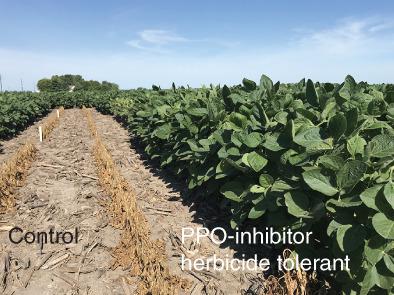当前位置:
X-MOL 学术
›
Pest Manag. Sci.
›
论文详情
Our official English website, www.x-mol.net, welcomes your feedback! (Note: you will need to create a separate account there.)
Microbial HemG-type protoporphyrinogen IX oxidase enzymes for biotechnology applications in plant herbicide tolerance traits.
Pest Management Science ( IF 3.8 ) Pub Date : 2019-10-20 , DOI: 10.1002/ps.5613 Clayton T Larue 1 , Joel E Ream 1 , Xuefeng Zhou 1 , Farhard Moshiri 1 , Arlene Howe 1 , Michael Goley 1 , Oscar C Sparks 1 , Steven T Voss 1 , Erin Hall 1 , Christine Ellis 1 , Janice Weihe 1 , Qungang Qi 1 , Daniela Ribeiro 1 , Xiaoping Wei 1 , Shirley Guo 1 , Artem G Evdokimov 1 , Marguerite J Varagona 1 , James K Roberts 1
Pest Management Science ( IF 3.8 ) Pub Date : 2019-10-20 , DOI: 10.1002/ps.5613 Clayton T Larue 1 , Joel E Ream 1 , Xuefeng Zhou 1 , Farhard Moshiri 1 , Arlene Howe 1 , Michael Goley 1 , Oscar C Sparks 1 , Steven T Voss 1 , Erin Hall 1 , Christine Ellis 1 , Janice Weihe 1 , Qungang Qi 1 , Daniela Ribeiro 1 , Xiaoping Wei 1 , Shirley Guo 1 , Artem G Evdokimov 1 , Marguerite J Varagona 1 , James K Roberts 1
Affiliation

|
BACKGROUND
Protoporphyrinogen IX oxidase (PPO)-inhibiting herbicides act by inhibiting a key enzyme in the heme and chlorophyll biosynthetic pathways in plants. This enzyme, the PPO enzyme, is conserved across plant species. However, some microbes are known to utilize a unique family of PPO enzymes, the HemG family. This enzyme family carries out the same enzymatic step as the plant PPO enzymes, but does not share sequence homology with the plant PPO enzymes.
RESULTS
Bioinformatic analysis was used to identify putative HemG PPO enzyme variants from microbial sources. A subset of these variants was cloned and characterized. HemG PPO variants were characterized for functionality and tolerance to PPO-inhibiting herbicides. HemG PPO variants that exhibited insensitivity to PPO-inhibiting herbicides were identified for further characterization. Expression of selected variants in maize, soybean, cotton and canola resulted in plants that displayed tolerance to applications of PPO-inhibiting herbicides.
CONCLUSION
Selected microbial-sourced HemG PPO enzyme variants present an opportunity for building new herbicide tolerance biotechnology traits. These traits provide tolerance to PPO-inhibiting herbicides and, therefore, could provide additional tools for farmers to employ in their weed management systems. © 2019 Society of Chemical Industry.
中文翻译:

微生物HemG型原卟啉原IX氧化酶用于生物技术在植物除草剂耐受性方面的应用。
背景技术抑制原卟啉原IX氧化酶(PPO)的除草剂通过抑制植物血红素和叶绿素生物合成途径中的关键酶起作用。这种酶(PPO酶)在整个植物物种中都是保守的。然而,已知某些微生物利用独特的PPO酶家族,即HemG家族。该酶家族执行与植物PPO酶相同的酶促步骤,但是不与植物PPO酶共享序列同源性。结果生物信息学分析用于鉴定微生物来源的推测的HemG PPO酶变体。克隆并表征了这些变体的一个子集。HemG PPO变体的功能和对抑制PPO的除草剂的耐受性得到了表征。鉴定出对抑制PPO的除草剂不敏感的HemG PPO变体,以便进一步鉴定。所选变体在玉米,大豆,棉花和油菜中的表达导致植物表现出对PPO抑制性除草剂应用的耐受性。结论选定的微生物来源的HemG PPO酶变体为建立新的除草剂耐受性生物技术性状提供了机会。这些特性对PPO抑制性除草剂具有耐受性,因此可以为农民提供其他工具,供其在杂草管理系统中使用。©2019化学工业协会。这些性状对抑制PPO的除草剂具有耐受性,因此可以为农民提供其他工具,供其在杂草管理系统中使用。©2019化学工业协会。这些性状对抑制PPO的除草剂具有耐受性,因此可以为农民提供其他工具,供其在杂草管理系统中使用。©2019化学工业协会。
更新日期:2019-10-21
中文翻译:

微生物HemG型原卟啉原IX氧化酶用于生物技术在植物除草剂耐受性方面的应用。
背景技术抑制原卟啉原IX氧化酶(PPO)的除草剂通过抑制植物血红素和叶绿素生物合成途径中的关键酶起作用。这种酶(PPO酶)在整个植物物种中都是保守的。然而,已知某些微生物利用独特的PPO酶家族,即HemG家族。该酶家族执行与植物PPO酶相同的酶促步骤,但是不与植物PPO酶共享序列同源性。结果生物信息学分析用于鉴定微生物来源的推测的HemG PPO酶变体。克隆并表征了这些变体的一个子集。HemG PPO变体的功能和对抑制PPO的除草剂的耐受性得到了表征。鉴定出对抑制PPO的除草剂不敏感的HemG PPO变体,以便进一步鉴定。所选变体在玉米,大豆,棉花和油菜中的表达导致植物表现出对PPO抑制性除草剂应用的耐受性。结论选定的微生物来源的HemG PPO酶变体为建立新的除草剂耐受性生物技术性状提供了机会。这些特性对PPO抑制性除草剂具有耐受性,因此可以为农民提供其他工具,供其在杂草管理系统中使用。©2019化学工业协会。这些性状对抑制PPO的除草剂具有耐受性,因此可以为农民提供其他工具,供其在杂草管理系统中使用。©2019化学工业协会。这些性状对抑制PPO的除草剂具有耐受性,因此可以为农民提供其他工具,供其在杂草管理系统中使用。©2019化学工业协会。






































 京公网安备 11010802027423号
京公网安备 11010802027423号